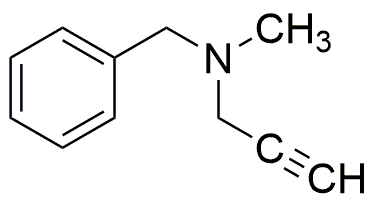Pargyline is widely utilized in research focused on:
- Neuroprotection: Pargyline is used in studies investigating its potential to protect neurons from damage, particularly in neurodegenerative diseases like Parkinson's. Its ability to inhibit monoamine oxidase (MAO) can help increase levels of neurotransmitters, which is beneficial in maintaining cognitive function.
- Antidepressant Research: Researchers explore its role as an antidepressant due to its MAO-inhibiting properties. This can lead to enhanced mood and emotional well-being, making it a subject of interest in the development of new antidepressant therapies.
- Cardiovascular Studies: Pargyline has applications in cardiovascular research, where it is examined for its effects on blood pressure regulation and vascular health, potentially offering benefits in managing hypertension.
- Pharmaceutical Development: The compound serves as a valuable reference in the synthesis of other pharmaceuticals, particularly those targeting neurological conditions, due to its unique chemical structure and properties.
- Research on Aging: Pargyline is investigated for its potential effects on aging processes, particularly in extending lifespan in model organisms, which could have implications for age-related health issues.
General Information
Properties
Safety and Regulations
Applications
Pargyline is widely utilized in research focused on:
- Neuroprotection: Pargyline is used in studies investigating its potential to protect neurons from damage, particularly in neurodegenerative diseases like Parkinson's. Its ability to inhibit monoamine oxidase (MAO) can help increase levels of neurotransmitters, which is beneficial in maintaining cognitive function.
- Antidepressant Research: Researchers explore its role as an antidepressant due to its MAO-inhibiting properties. This can lead to enhanced mood and emotional well-being, making it a subject of interest in the development of new antidepressant therapies.
- Cardiovascular Studies: Pargyline has applications in cardiovascular research, where it is examined for its effects on blood pressure regulation and vascular health, potentially offering benefits in managing hypertension.
- Pharmaceutical Development: The compound serves as a valuable reference in the synthesis of other pharmaceuticals, particularly those targeting neurological conditions, due to its unique chemical structure and properties.
- Research on Aging: Pargyline is investigated for its potential effects on aging processes, particularly in extending lifespan in model organisms, which could have implications for age-related health issues.
Documents
Safety Data Sheets (SDS)
The SDS provides comprehensive safety information on handling, storage, and disposal of the product.
Product Specification (PS)
The PS provides a comprehensive breakdown of the product’s properties, including chemical composition, physical state, purity, and storage requirements. It also details acceptable quality ranges and the product's intended applications.
Certificates of Analysis (COA)
Search for Certificates of Analysis (COA) by entering the products Lot Number. Lot and Batch Numbers can be found on a product’s label following the words ‘Lot’ or ‘Batch’.
*Catalog Number
*Lot Number
Certificates Of Origin (COO)
This COO confirms the country where the product was manufactured, and also details the materials and components used in it and whether it is derived from natural, synthetic, or other specific sources. This certificate may be required for customs, trade, and regulatory compliance.
*Catalog Number
*Lot Number
Safety Data Sheets (SDS)
The SDS provides comprehensive safety information on handling, storage, and disposal of the product.
DownloadProduct Specification (PS)
The PS provides a comprehensive breakdown of the product’s properties, including chemical composition, physical state, purity, and storage requirements. It also details acceptable quality ranges and the product's intended applications.
DownloadCertificates of Analysis (COA)
Search for Certificates of Analysis (COA) by entering the products Lot Number. Lot and Batch Numbers can be found on a product’s label following the words ‘Lot’ or ‘Batch’.
*Catalog Number
*Lot Number
Certificates Of Origin (COO)
This COO confirms the country where the product was manufactured, and also details the materials and components used in it and whether it is derived from natural, synthetic, or other specific sources. This certificate may be required for customs, trade, and regulatory compliance.


